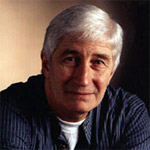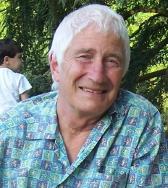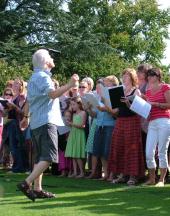
DAVID BEDFORD
4th August 1937 1st October 2011
I was inventive through ignorance
By Tim Reynish
Revised March 2012.

David Bedford, who died on 1st October, 2011, at the age of 74, was mourned alike by the classical and pop music worlds. David was born in London in 1937 of a musical family, (his brother is Steuart Bedford the conductor, his grandmother was the composer Liza Lehmann, and his mother, Lesley Duff, was a member of the English Opera Group just after the war and was thus involved in several Britten premières).
He began composing at the age of seven and went on to study at the Royal Academy of Music with Lennox Berkeley. Later, he became something of an enfant terrible, but experiences as an arranger in the 1970s rock scene tempered his early training with Luigi Nono at the electronic studios in Milan, and throughout his career he worked with a number of leading rock stars such as Kevin Ayres, Mike Oldfield, Elvis Costello, Frankie goes to Hollywood, Roy Harper, Propaganda, China Crisis, Enya, Billy Bragg. But, as he once recalled: I was on the road playing keyboards with these bands, fighting off the groupies, and then the next night I would be in the Festival Hall doing some plinky-plonk music to an audience of about four.
A very successful career in commercial music beckoned, but early experience as associate visiting composer at Gordonstoun School led him into sharing his expertise with music in all its forms, educational, amateur, pop and avant garde, as well as being extraordinarily active in musical politics; he was chairman of the Performing Rights Society from 2001.
One of his last works was The Wreck of the Titanic, written for school choirs in Cumbria, Lancashire and Liverpool, commissioned by local authorities in the region and premiered in Liverpools Philharmonic Hall in 2010. His music in this genre ranges from small pieces for pupils with little or no musical knowledge, to 7 school operas. He was in frequent demand for creative workshops and composition projects throughout the U.K. and overseas. His innovative approach has led to such works as 'Seascapes' (1986) and 'Frameworks' (1989), in which students are encouraged to create their own music in the context of a public concert with a professional orchestra - these two pieces have so far involved over 4000 students. His largest major educational piece is 'Stories from the Dreamtime', (1991) for 40 deaf children and symphony orchestra.
For over 30 years he has received commissions from major orchestras, festivals, ensembles and soloists, including the Royal Philharmonic Orchestra, London Philharmonic Orchestra, Royal Liverpool Philharmonic Orchestra, English Sinfonia, Scottish Chamber Orchestra, John Alldis Choir, Singcircle, Electric Phoenix, Endymion Ensemble, Sir Peter Pears, Jane's Minstrels, BASBWE, The Composers Ensemble, The Aldeburgh Festival, Harrogate Festival, Spitalfields Festival, Chelmsford Festival, Huddersfield Festival, Kings Lynn Festival, Norfolk and Norwich Festival and many BBC commissions including 4 for the Proms. Clark Rundell and the Royal Northern College of Music Wind Orchestra recorded a number of his works for wind in 1997. Musicweb carried a review of the CD: Anyone who is familiar with David Bedford only through his early work (Im thinking of such pieces as Star Clusters, Nebulae and Places in Devon and several of the other celestial inspired works of the sixties and seventies) would, I suspect, be hard pressed to recognise the music on this disc as being by the same composer. In reality however, it is no great surprise that Bedfords music underwent a gradual change during the late seventies and early eighties.
After early studies with Lennox Berkeley and Luigi Nono his initial immersion in the world of the avant-garde always ran parallel with his involvement in popular music, working regularly with such figures as Mike Oldfield and also undertaking arrangements for a wide range of mass market artists. The compositional style that was to emerge from this post avant-garde world was strongly melodic, unashamedly tonal and not uninfluenced by the popular music that had always been part of his musical persona. A good example can be found in the Symphony No. 1 of 1985 (NMC D049). The Symphony is contemporaneous with several of the wind band pieces on this disc and is not too distant from them, both melodically and in the use of certain rhythmic devices that crop up regularly in his work.

Sun Paints Rainbows on the Vast Waves was the first of a number of wind band pieces that was to create something of a reputation for Bedford as fresh interest began to grow in symphonic wind bands. This was largely as a result of the work of Timothy Reynish and Clark Rundell at the Royal Northern College of Music in Manchester. The work takes its title from the notebook of Coleridge when he was writing The Rime of the Ancient Mariner, the Sea was then very much tossed, and the Wind carrying off the Tops of the Waves made a kind of Rain, in which the rays of the Sun, painted the Colours of the Rainbows. Bedford creates what amounts to a tone poem, based largely on the eight chords heard at the outset. As in much of Bedfords music considerable use is made of repeated ostinato-like rhythmic figurations that occur regularly and are a stylistic remnant of his avant-garde days. The initial eight chords are subjected to a range of transformations and metamorphoses, heard most obviously in the middle section where they are presented in a series of static blocks set against percussion.
Sun Paints Rainbows on the Vast Waves |
The Wind Music of David Bedford
| Praeludium | 1990 |
| Sun Paints Rainbows on the Vast Waves | 1982 |
| Canons and Cadenzas | 1995/6 |
| Sea and Sky and Golden Hill | 1985 |
| Ronde for Isolde | 1985 |
| The Royal Northern College of Music Wind Orchestra/Rundell | Doyen DOY CD 082 |
In my web pages on British Wind Music, I wrote:
DAVID BEDFORD AND THE TINGLE FACTOR

In 1985, Conference moved to Bristol; the BASBWE Commission was David Bedford's Sea and Sky and Golden Hill (1985, Novello/Music Sales), with its evocative use of tuned wine glasses. His scores show a fascination for unusual soloists, piccolo, cor anglais, bass clarinet, baritone saxophone; he was writing minimalist scores before it was fashionable, and his love of the tingle-factor, often caused by sharply contrasted overlapping common chords piled into huge masses, abruptly switching to ppp or to silence, makes his work very dramatic, albeit needing a large acoustic for full effect.
In Rondo for Isolde (1985, Novello) and the Symphony No. 2 (1995, Novello) he has created two fine works for schools to stand alongside the best pieces by Connor, Ellerby, Sparke, Woolfenden and Wilby. Praeludium (1990, Novello) makes use of four antiphonal groups drawn from the main band, which remains on stage, while the BASBWE Trust commission for the Leeds Festival is a piano concertante work, Susato Variations (1993, Novello) with orchestral wind accompaniment.
The most successful work internationally is still Sun Paints Rainbows on the Vast Waves (1982, Novello) written for the Huddersfield Contemporary Music Festival. The score is a facsimile of his original manuscript, and there are a number of mistakes in the parts. Some of these mistakes had been noted in an errata list published by Novellos, others have been spotted more recently as a result of a performance I gave with the Band of HM Royal Marines. Please send in any that you spot.
Many of the misprints are listed here (PDF download)
Sun Paints Rainbows On The Vast Waves Mistakes in the following parts:
Cor anglais, Eb clarinet, Bb clarinets 1 2 & 3,, alto and bass clarinets, Saxes 1 2 3 4, Horns 1,2,3,4, Cornet 3, trumpets 1,2 3, Trombones 1,2 3, perc 4 marimba and bottle 4.
SUN PAINTS RAINBOWS ON THE VAST WAVES (1984) wind band
Duration: 14 mins.
Commissioned by: Huddersfield Festival Published by: Novello and Co Ltd
SEA AND SKY AND GOLDEN HILL (1985) wind band
Duration: 12 mins.
Commissioned by: BASBWE Published by: Novello and Co Ltd
RONDE FOR ISOLDE (1986) wind band (also version for orchestra)
Duration: 10 mins.
Commissioned by: National Wind Band of Scotland Published by: Novello and Co Ltd
SYMPHONY 2 (1987) wind band
Duration: 14 mins.
Commissioned by: Herts Wind Band Published by: Novello and Co Ltd
TOCCATA FOR TRISTAN (1989) brass band
Duration: 15 mins.
Commissioned by: BBC Published by: Novello and Co Ltd
PRAELUDIUM (1990) wind band. 4 antiphonal groups and main group on stage
Duration 5.30 mins
Commissioned by the Royal Northern College of Music Published by Novello
CANZONA (1992) solo trombone, 4 tpt, flg, hn, 3 tbn, euph, tba, perc
Duration: 14 mins.
Commissioned by: Corus Brass Ensemble Published by: David Bedford
SUSATO VARIATIONS (1992) piano solo, 3fl, 3ob, 3cl, 3bsn, 4hn, 3 tpt,3 tbn, tba, 3 perc
Duration: 21 mins.
Commissioned by: BASBWE Education Trust Published by: David Bedford
CANONS AND CADENZAS (1995-96) wind band
Duration: 15 mins
Commissioned by: Frederick Fennell Published by: G and M Brand Publications Ltd.
REQUIEM (1998)brass band
Duration: 11 mins.
Commissioned by: National Youth Brass Band of Great Britain, Published by: Maecenas Music
SPRITES, ELVES AND BLUE JETS (2000) wind band and string orchestra
Duration: 11 mins
Commissioned by: Hampshire Youth Orchestra Published by: David Bedford